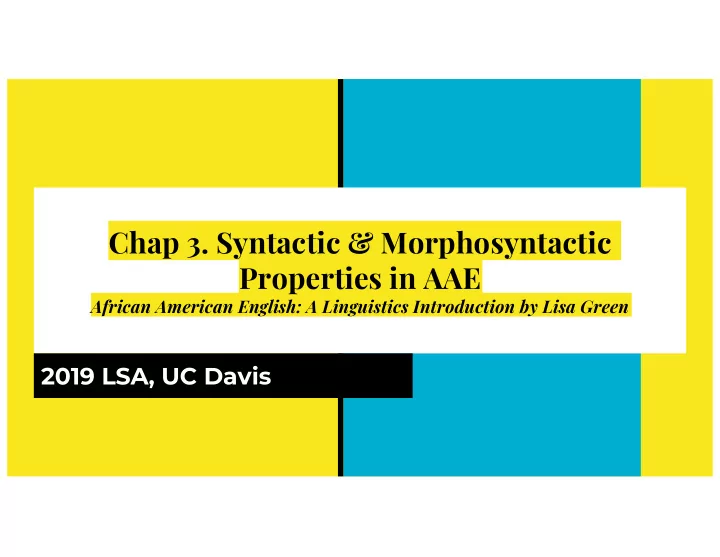

Chap 3. Syntactic & Morphosyntactic Properties in AAE African American English: A Linguistics Introduction by Lisa Green 2019 LSA, UC Davis
Negation Multiple negation : - multiple negators such as no , nothing, don’t, ain’t can be used in a single sentence - Example: I ain’t never seen no one do that before.* These ‘extra’ negative elements in AAE don’t contribute any additional negative meaning to sentences Negative inversion : 2 clause initial elements (an auxiliary and indefinite NP) are obligatory marked for negation - Example 1: Don't no game last all night long (can also be: No game don’t last all night) - Don’t = the initial negated auxiliary - no game = negative indefinite NP (it’s not referring to any game in particular - Example 2: Can’t nobody tell you it wasn’t meant for you. These also look like yes-no questions a. Don’t nobody want to go to the movies. b. Do anybody want to go to the movies? *all cited examples are the author’s
Negation cont: Why might speakers use negative inversion? Also takes different forms in different dialects Prosodic prominence to the negative Adds affect Other sociopragmatic factors?
Existential it and dey Occur in constructions in AAE that are used to indicate that something exists ● General form for existential construction is: ● Existential element - linker- logical subject It be too many cars in the parking lot Common patterns when using it and dey ● -it’s is pronounced as [Is] when it’s followed by got and have - it followed by got and have -dey followed by a NP - dey followed by got and have
Questions Yes-no questions 1. Can be formed without overt auxiliaries; prosodic cues Example: You know her name? He sleeping in the car? 2. The auxiliary DO precedes the subject. Examples: It do be dark (declarative) > Do it be dark? 3. DO can also be inserted at the beginning of sentences. Example: He be sleeping (declarative) > Do he be sleeping in the car?
WH-Questions General pattern: WH-word will be clause initial Auxiliary (if there is one) assumes a position immediately preceding the subject Example: Why (do) y’all want to treat me like this? WH-word will be clause initial + AUX (either follows the subject or doesn’t occur at all) Example: Why they ain’t growing? What they was doing? (also acceptable: What was they doing? ) In the case of constructions with no overt auxiliary, the WH-word goes in front of its declarative counterpart. Example: You be talking to _ like that. > Who you be talking to like that? 3 main patterns of WH-questions in AAE: Examples (1) WH-WORD AUX SUBJ What did you eat? (2) WH-WORD SUBJ AUX Why those ppl don’t want to take that?
Relative clauses Modifies preceding noun, might have a relativizer, that or who ● I know the person who you talking about ○ Optional sometimes when modifying predicate nominative or object ● position You’re the one (who) be telling me → predicate nominative “You” ○ We got one girl (who) be here every night → object “girl” ○
Preterite had A syntactic feature mainly used by preadolescent, adolescent to young ● adults Preterite (i.e. past tense) vs. pluperfect had (i.e. past perfect) ● Same form: had + past tense verb ○ Different meaning ○ That’s why at W. E. we had discussed a lot. ■ We talked about this last year. That’s the test I had failed . ■
Morphosyntactic properties Past Morphology Both past and past participle forms are used in AAE ● BIN constructions bear both morphologies ● BIN + verb = the state that the subjects have been in for a long time ● BIN + past = I could’a BIN went back ○ BIN + past participle = Aw, he BIN gone ○
Morphosyntactic properties Adjectival readings prefer the past participle ● The stew BIN gone. ○ Verbs following d ə n (be d ə n/BIN d ə n) bear both morphologies ● Some activity has ended and is in the resultant state ● You d ə n got this far ○ You d ə n been here a year ○
Morphosyntactic properties The distinction between past and past participle? ● Gone (more adjectival uses) vs. went (more verbal uses) ○ Seen vs. saw (seen in past participle context: she just want to be seen) ○ Sometimes aspectual be can be used in exchange for BIN and d ə n ● It be done before I think about it. ○ Breakfast be cooked at 8 o’clock. ○
Morphosyntactic properties Verbal -s Plural form without verbal -s = default form ● When he come down here, I be dən talked to him. ○ Verbs marked with verbal -s = ● 3rd person singular agreement marker ○ narrative present marker ○ Judge: What happened? ■ Woman: He had called me Wednesday afternoon and asked, “Do you want to do the ■ movies”... so I gets in the car. habitual marker ○ I can show you some of the stuff we tesses them on. ■
Morphosyntactic properties Genitive marking ’s not obligatory in AAE ● Word order is sufficient to mark the possessive relationship ● Variations among different speakers ● I always get bites cause we be hanging out at my mama house . ○ That’s the church responsibility . ○ I’ll be d ə n reached across that counter and pulled that woman’s hair out. ○
Recommend
More recommend